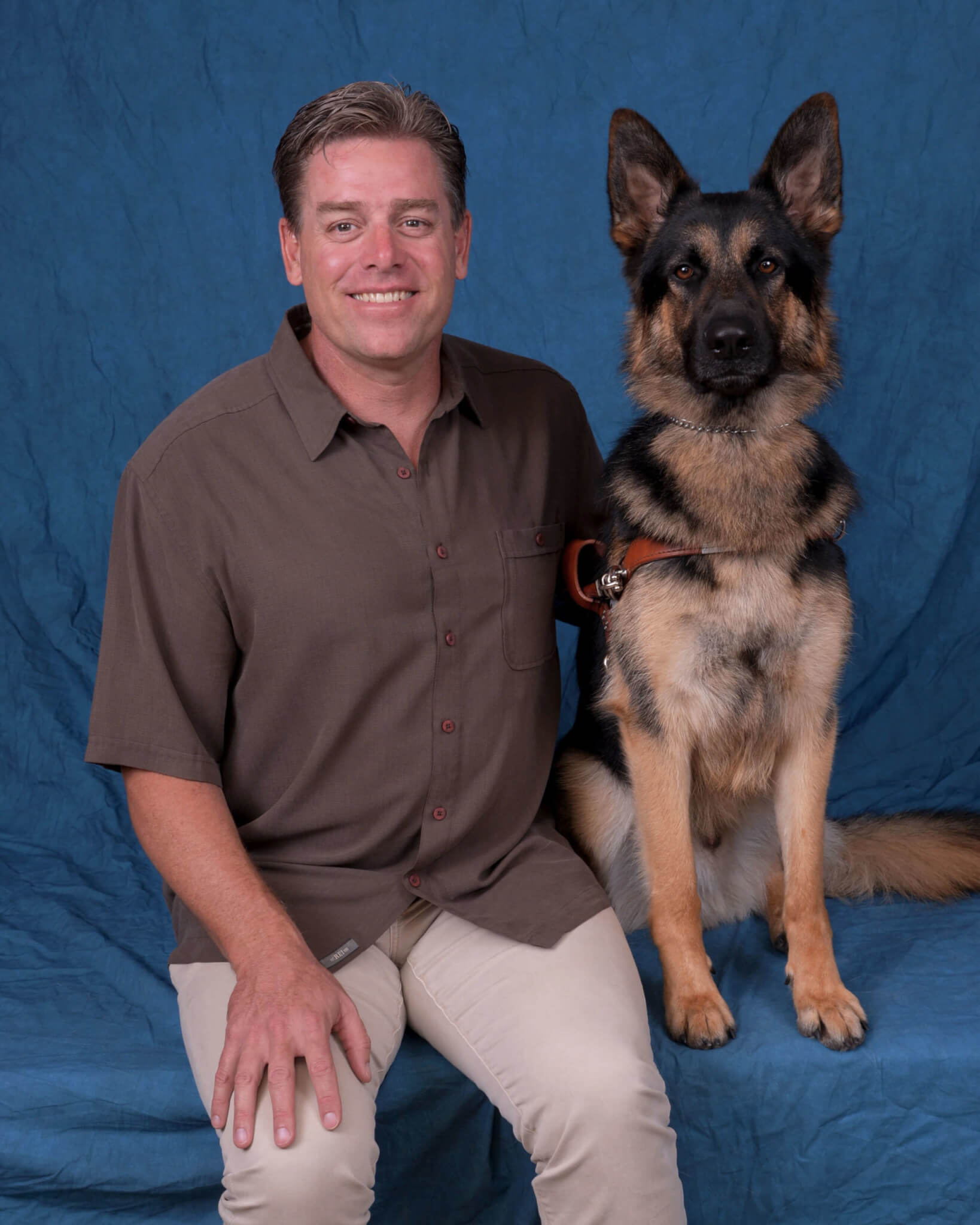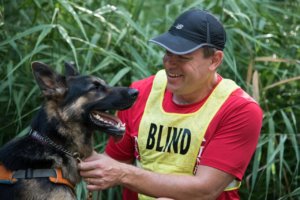Main Menu

My name is Richard Hunter and I live outside of Sacramento California. I have a lovely wife of 24 years, and three lovely daughters, 18, 14, and 9. I am losing my vision due to a hereditary eye condition called retinitis pigmentosa. I’ve lost the majority of my vision, but what makes me unique is that I have chosen to embark upon endurance sports as a form of recreational rehabilitation.
A big year for me was 2013, a pinnacle year for me and my activities. I began the year by learning how to use sighted guides to run on single track trails that I couldn’t see near my home. My goal was to run and to finish the American 50 mile endurance run, which I completed in 10 hours, 24 minutes, and 35 seconds. And then on July 4th, a great friend of mine, also a retired U.S. Marine, strapped himself to me and we plunged into Lake Natoma embarking on a 4.5 mile open water swim. I’m not a great swimmer, it took me 3 hours, but I was able to finish nonetheless. And then on July 5th, the next day, I was scheduled for a five-hour tandem bicycle ride with my Iron Man triathlon friend, Justin. We were two hours into a five hour bike ride and 91-year-old woman who didn’t see us – the sun was in her eyes – hit us nearly head-on going about 20 miles per hour. My sighted guide, Justin, hit the ground after he ricocheted off the hood of the car. I went off the back of the tandem bike and right through the windshield of the car. I later I woke up inside of the car and emergency personnel were on the scene, apparently my head was in the lap of the lady who was driving the car, my helmet was broken in half, I had two facial fractures, a severe concussion, multiple lacerations, a broken neck, and I had lost several units of blood in the front seat of the car. When I awoke dazed and confused I was strangely alert to what was going on around me…As I started to move, they told me there was a lot of blood and there was a lot of glass, and I could sense the anxiety around me. They were basically treating me as I was going to die. I said my final prayers, not knowing. Well, obviously, that was not the plan. I was extricated from the car and was taken to a trauma center by a medical helicopter.

When I went home I had a neck brace for three months, I had a hospital bed in my living room for a month. That was a very, very, tough time. But, two months after I got my neck brace off, five months and three days after my accident, I crossed the finish line of a marathon. I went on to run the Boston marathon in 2014, and I swam from Alcatraz to San Francisco 11 months after I was hit by that car. Now what does this all have to do with a guide dog school? The day of my accident was an exclamation mark for my family. Anybody who has been through something traumatic, if you’re the person in those shoes, you can endure it. But you suffer for your family and you see what impact it has on them. Everybody in my family became hypersensitive about my safety, and they knew that even though I have a lot of resources, more resources than a lot of people in terms of sighted running guides – I run 6 days a week to train for my events, and I don’t have someone to run with every day. I know my familiar routes around my neighborhood, so I run then slowly, but by myself. I’ve gotten hurt a little bit many times. So my middle daughter, once again, asks, “Dad, when are you going to get a guide dog?” And I said, “You know Lindsay, for the millionth time, if I could have a guide dog that could run with me, and keep me safe, I would have gotten one years ago. But no guide dog school allows that.”
So you fast forward to 2013, when I met Thomas Panek, just a few hundred yards from the start of the Boston Marathon, it just so happens that I was sitting next to this gentleman from Colorado and we were having a conversation about running with guide dogs, and there came Thomas. As Thomas came a long, I said “Thomas! You’re the CEO of a guide dog school, you’re a visually impaired marathoner, you have a guide dog, what do you think about having guide dogs that can run with you?” What a great day! So what does this mean to me? This means safety, it means freedom, it means companionship, peace of mind for my family. It also means when Klinger and I are successful, it will give others the opportunity to follow in our shoes. When Thomas wrote the first blog article describing the Running Guides program months ago, I was contacted by a runner from Kalamazoo, Michigan. She called me and she said “Richard, I was so excited, I couldn’t sleep all night long.” As hard as she was working, she just could not find enough people to train with in her community, and that’s just one story.
I had the privilege of going over to the Canine Development Center to visit seven-week-old German Shepherd puppies (making Klinger a father!). As I was sitting there, and reflecting, I came across the fact that Klinger’s birth date is May 31, 2013. Klinger was in the Whelping Kennel of the Guiding Eyes Canine Development Center on the day of my accident. And I started reflecting on that and I thought, Klinger, and all of the other guide dogs that graduated in this class, when they are brought into this world, Klinger’s purpose in life was to be joined to me. He’s not going to work for a couple of years and move onto someone else, I am the person that he is going to come alongside, and I thank everybody, from the breeding staff, the socializers, the puppy raisers, the training staff, the administrative staff, and everybody who has put in the extra time and effort to make this Running Guides Pilot Program project possible. Thank you very much.
